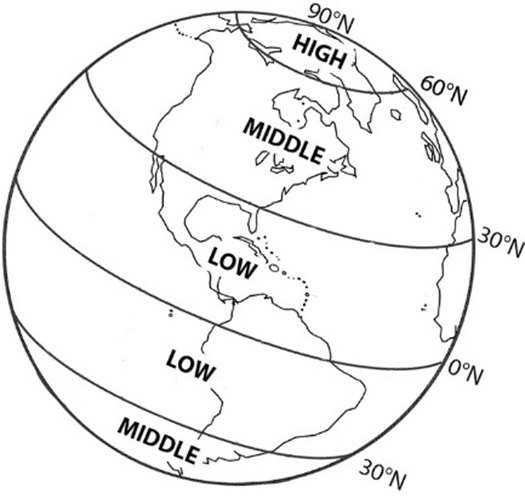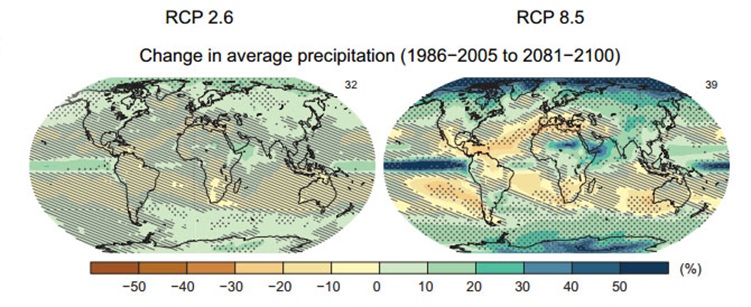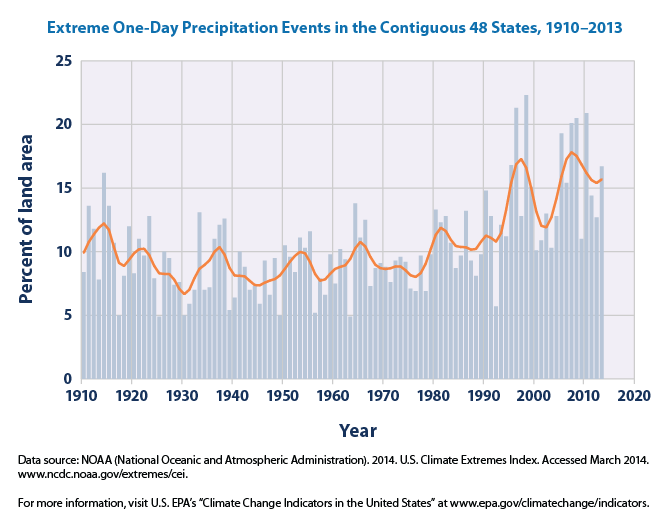Precipitation
Earth’s water cycle changes in response to natural variability, but scientists are becoming more certain that the human impact of increasing greenhouse gas emissions will cause more changes to the water cycle. Evaporation rates will increase with a warmer climate, causing an increase in the amount of moisture in the lower atmosphere. With higher water vapor concentrations, there is an increased frequency of intense precipitation events, primarily over land areas. In addition, there will be greater chances of the precipitation falling as rain than snow due to the warmer temperatures. However, precipitation changes around the globe will not be uniform. Some areas will actually see decreases in precipitation.
The figure below shows the projected changes in average precipitation for the low and high scenarios (RCP 2.6 and RCP 8.5). The figure shows the changes in average precipitation for 2081-2100 relative to 1986-2005. Study the figure below and compare the projected changes for the two scenarios.
 You should see that there is an approximate 30% or greater difference in the projected average precipitation for the two scenarios. However, as previously stated, the changes in precipitation around the globe are not uniform––increasing in some areas and decreasing in others.
You should see that there is an approximate 30% or greater difference in the projected average precipitation for the two scenarios. However, as previously stated, the changes in precipitation around the globe are not uniform––increasing in some areas and decreasing in others.
Study the IPCC’s projected change in average precipitation for the RCP 8.5 scenario. Complete the table below with either “increase” or “decrease” to describe the change in annual precipitation. Use the globe figure as a reference.
Likely Changes in Global Precipitation by 2100
Latitude |
Annual Mean Precipitation |
|---|---|
| High | |
| Mid/Subtropical Dry | |
| Mid/Wet | |
| Low/Equatorial |
Check Your Responses [correct-green, incorrect-red]
The high latitudes (such as the polar regions) and the equatorial Pacific Ocean are likely to experience an increase in annual mean precipitation by the end of this century for the RCP 8.5 scenario. For many mid-latitude subtropical dry regions (such as northern and southern Africa), the mean precipitation will likely decrease. Meanwhile, in many mid-latitude wet regions (such as North American and Europe), mean precipitation will likely increase by the end of this century under the RCP 8.5 scenario.
Extreme Precipitation
Extreme precipitation events are events in which the amount of precipitation in a location exceeds the normal for that location. Globally, extreme precipitation events over most mid-latitude land masses and wet tropical regions will very likely become more intense and more frequent as global mean temperature increases.
The EPA’s 2014 Climate Change Indicators in the United States report shows the prevalence of extreme one-day events remained fairly steady throughout the 1900s until about 1980. In recent years, however, extreme precipitation events have been increasing. This increase in events does not necessarily mean that total precipitation amounts are increasing but that the precipitation is occurring in more intense one-day events.
The figure shows the percentage of land area in the contiguous 48 states from 1910-2013 where there was a much greater-than-normal portion of the total annual precipitation resulting from extreme single-day precipitation events. The gray bars in the figure represent the individual years and the red line is the nine-year average.
Flooding
Flooding is defined as an overflow of water onto normally dry land and is considered the most common natural disaster in the U.S. As extreme rain events increase, flooding events are also expected to increase. A flooding event can be caused by human-related factors. Consider the floods that occurred after Hurricane Katrina when the levees protecting the city of New Orleans failed. However, the majority of floods are related to weather events. There are four main types of these weather-related flooding events:
- Flash floods,
- Urban flooding,
- River flooding, and
- Coastal flooding.
A flash flood is a short-term event, happening within just a few hours, caused by heavy precipitation as well as rapid snowmelt, or the failure of dams or levees. Urban flooding, caused by short-term heavy precipitation, occurs as a result of the large areas of impervious surfaces (such as roads, pavement, parking lots, and buildings). River flooding occurs when a river fills with water (drained from the surrounding watershed) and exceeds the channel capacity and overflows the banks to inundate adjacent low lying areas. Finally, storm surges that accompany hurricanes and other coastal storms push large seawater domes toward the shore causing coastal flooding.
View the following NASA video to review what happens when there is too much or too little precipitation.
Video Source: NASA Goddard


![By Anthony Quintano [CC BY 2.0 (http://creativecommons.org/licenses/by/2.0)], via Wikimedia Commons 2014BuffaloSnowStorm](/nasa/images/impacts/WinterStormBuffalo.jpg)

![By Vybr8 [Public domain], via Wikimedia Commons Flooding After Katrina](http://upload.wikimedia.org/wikipedia/commons/thumb/0/0b/New_Orleans_msi_9mar2004_31aug2005-Merge.gif/256px-New_Orleans_msi_9mar2004_31aug2005-Merge.gif)